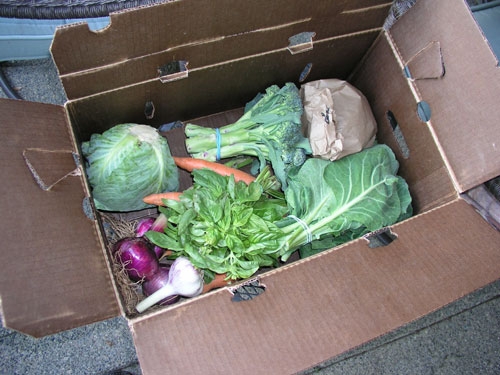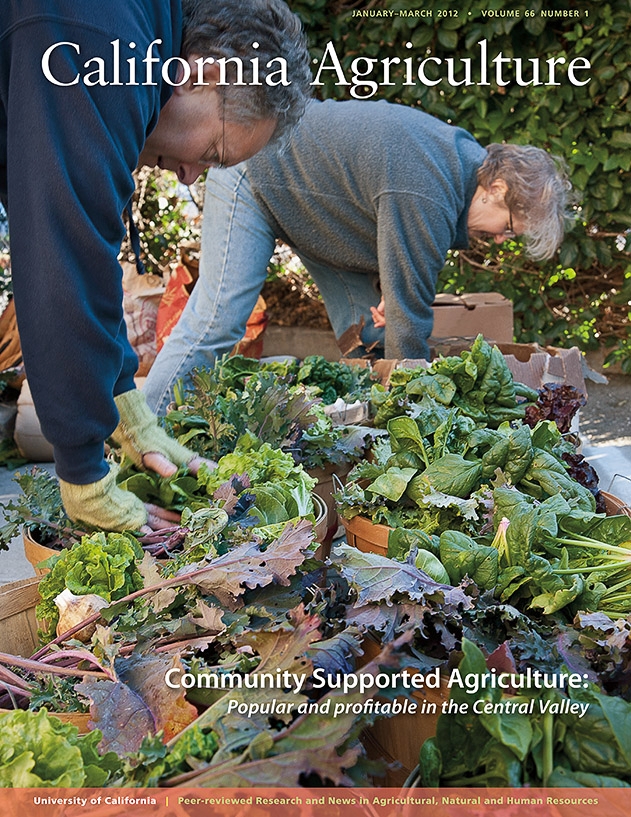Posts Tagged: Ryan Galt
Community supported agriculture prospering in Central Valley
Community Supported Agriculture (CSA) – a way of buying fresh produce and other foods directly from farmers – is growing rapidly in California’s Central Valley, according to a newly published study in the California Agriculture journal.
Membership in the CSAs surveyed for the study increased from an estimated 672 in 1990 to 32,938 in 2010.
The growth in Central Valley CSAs is one part of a bigger movement toward stronger direct relationships between farmers and consumers, said Ryan Galt, UC Davis assistant professor in the Department of Human and Community Development and co-author of the study “Community Supported Agriculture is thriving in the Central Valley."
“Consumers increasingly want to connect with the farmers who grow their food,” Galt explained, while unpacking a cornucopia of vegetables from his own CSA box. “Food is an intimate thing, so I don’t think it’s strange that people want to establish relationships with those who produce it.”
While Galt’s study focuses on the farm, rather than consumer, side of the relationship, he said he joined a CSA for several reasons.
“I wanted to support a more ecologically oriented agriculture, and the livelihoods of farmers and farmworkers. And then, there is the benefit of not having to shop as much,” he added, snipping a bunch of deep purple beets from their greens.
It’s beet season in California. The dark root vegetable is relatively new to Galt’s culinary repertoire. Had it not shown up in the first CSA box to which he subscribed, years ago, he might never have learned to prepare it and would unlikely order it on a menu. The surprise and challenge of preparing new, interesting foods is among the reasons Galt still subscribes to a CSA.
Like most California CSA members, Galt picks up a basket of produce from a central location, not necessarily the farm itself. Some CSA farms deliver directly to homes. Few require members to visit the farm, but most host member events.
“CSA farmers provide their members more than food. They offer a direct connection to what is happening on the farm and with the seasons, they educate their members on agricultural and rural issues, and they share recipes that help members use their food,” Galt said, sliding a pot of beets into the oven.
It’s a lucrative exchange for CSA farmers, he adds. Average gross sales per acre for CSA farms is six times greater than average CA farms. Because people subscribe to their farm in the same way people subscribe to magazines, CSA farmers have a good idea how much to produce and harvest, and, most importantly for them, they have a promised market and up-front cash. Many young farmers are creating CSAs because of these benefits.
“CSA farmers are motivated by their love of farming and the satisfaction of providing fresh produce to grateful members,” Galt said.
Roasted beets
6 medium beets
2 tablespoons balsamic vinegar
2 teaspoons orange zest
Pepper
Preheat oven to 350 F. Wash the beets and put the unpeeled in a roasting pan with about an inch of water. Cover and bake for an hour, or until they are easily pierced with a folk. Slip off the skins after the beets have cooled. Slice the beets into wedges. Toss with vinegar, orange zest and pepper. Serve at room temperature.
Community Supported Agriculture grows rapidly in California’s Central Valley
Community Supported Agriculture (CSA) — farms that regularly provide fresh produce directly to members — is growing rapidly in California’s Central Valley and surrounding foothills, according to a new study published in the January–March 2012 issue of the University of California’s California Agriculture journal.
Total membership in the CSAs surveyed (n = 46) increased exponentially from an estimated 672 members in 1990 to 32,938 members in 2010. Most CSAs in California’s Central Valley and surrounding foothills were relatively small (20 acres on average), produced a broad range of crops (44 on average) and adhered to organic or sustainable growing practices.
Likewise, 54 percent of the CSA farms surveyed were profitable; of the rest, 32 percent broke even and 15 percent operated at a loss. Gross average sales for the CSAs surveyed were $9,084 per acre in 2009; this compares with average gross sales of $1,336 per acre for California agriculture in general.
Despite their increasing popularity, little is known about CSA farmers and their operations. UC researchers conducted a comprehensive study of CSA farmers in the Central Valley and surrounding foothills about their growing practices, farm economics, demographics and other characteristics. The article in full and the entire January–March 2012 issue of California Agriculture can be found at: http://californiaagriculture.ucanr.org.
CSAs eliminate distributors, forging direct connections between farmers and consumers; California has about 275 CSAs, and there are more than 3,500 nationally. The researchers found that CSAs are adapting and changing to meet consumer interest in and demand for locally produced food.
“Together with farmers markets, farm stands, U-picks and agritourism, CSAs constitute a ‘civic agriculture’ that is re-embedding agricultural production in more sustainable social and ecological relationships, maintaining economic viability for small- and medium-scale farmers and fulfilling the non–farm-based population's increasing desire to reconnect with their food,” Ryan Galt, UC Davis assistant professor in the Department of Human and Community Development, and co-authors wrote in California Agriculture journal.
The CSA model has undergone considerable change and innovation, the researchers found, with growers offering new products such as meat and dairy and making payment options more attractive to consumers. When the first CSAs were started on the East Coast in the mid-1980s, members paid in advance and received a share of the farm’s crop in return, and they also shared in production risks. Today’s CSAs allow consumers more flexibility and less risk. “Twenty percent of CSAs in the study had no minimum payment period, allowing week-by-week payments, which extends membership to a broader population, including those hesitant or unable to commit to extended payments,” the authors wrote.
The study team also interviewed CSA farmers about what motivated them. “Even though a CSA is hard work, farmers tend to find it rewarding,” Galt and co-authors noted. “The vast majority were happy with their work and continued to view the CSA as a viable option for small- and medium-scale farmers.”
Also in the January–March 2012 issue of California Agriculture:
Farm-to-WIC study: The federal Special Supplemental Nutrition Program for Women, Infants and Children (WIC) now distributes monthly cash vouchers to low-income women with children to buy fruits and vegetables. UC Cooperative Extension (UCCE) researchers surveyed WIC participants in Tulare, Alameda and Riverside counties in 2010 to guide the development of a farm-to-WIC program that would connect local growers to the WIC market. Based on WIC participants’ produce preferences and buying habits, they developed a list of 19 produce items for possible inclusion in the program, including broccoli, cabbage, collards, nopales, sweet potato and tomatillo.
Preventing Fusarium wilt of lettuce: Caused by the soilborne fungus Fusarium oxysporum f. sp. lactucae, Fusarium wilt affects all major lettuce production areas in California and Arizona. In trials at UC Davis, lettuce cultivars differed significantly in susceptibility to the disease, with some leaf and romaine types highly resistant under all test conditions. Management of Fusarium wilt requires an integrated approach that includes crop rotation to reduce soil inoculum levels and the use of resistant cultivars during the warmest planting windows.
Also in the online-only E-Edition of California Agriculture:
Biological control for citrus pests: In a spring 2010 survey and statistical analysis, growers with greater citrus acreage and more education were more likely to use biological controls for four important citrus pests (California red scale, citrus red mite, citrus thrips and cottony cushion scale). Marketing outlets, ethnicity and primary information sources also influenced the extent of reliance on beneficial insects.
California Agriculture is the University of California’s peer-reviewed journal of research in agricultural, human and natural resources. For a free subscription, go to: http://californiaagriculture.ucanr.org, or write to calag@ucdavis.edu.
WRITERS/EDITORS: To request a hard copy of the journal, e-mail jlbyron@ucdavis.edu.


